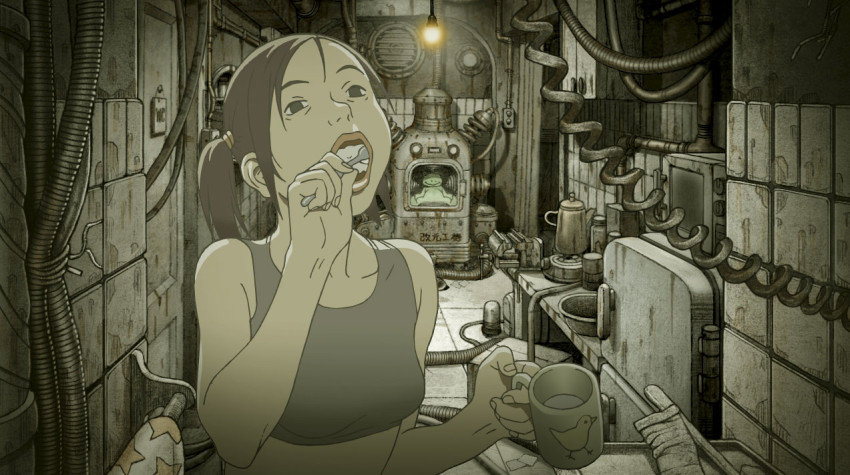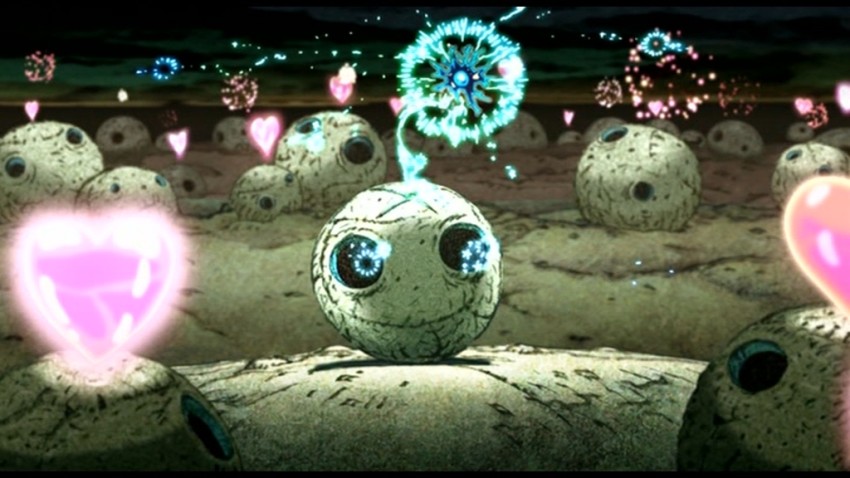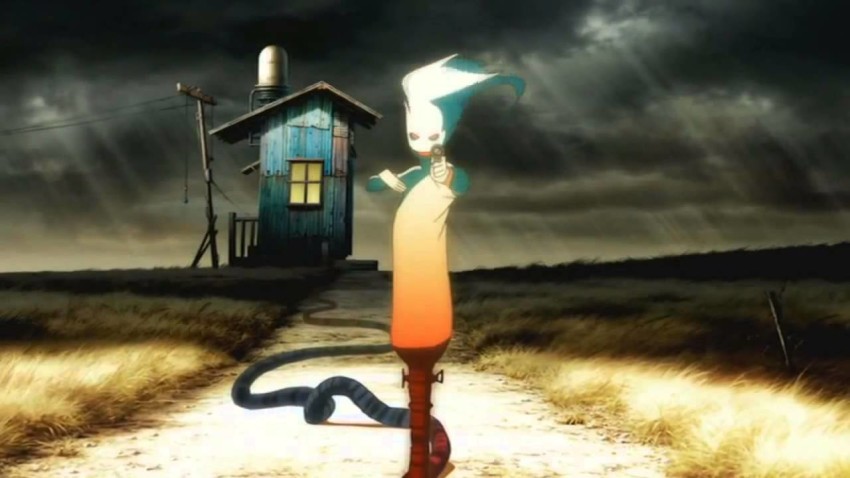Genius Party and Beyond
December 10, 2017 · 0 comments
By Andrew Osmond.
If you follow Anime Limited’s releases, you’ll know short is beautiful in animation. Titles such as Garden of Words, HAL and Tokyo Marble Chocolate do more in 40 or 50 minutes than most anime series manage in hours. Shorts present genre stories without formula fat, leaving lean tales swinging unusual ways without undue elaboration. Or the short films can leave genre behind and strike off in really weird directions, trusting that enough viewers won’t say, “I don’t get this, so it sucks”, but rather “I don’t get this, but I’ll watch it again and see if it makes more sense.”
Genius Party & Beyond is a collection of twelve short films, mostly between ten and twenty minutes each, amounting to a three-hour package. In Japan, the films were released in two feature-length blocks, Genius Party in 2007 and Genius Party Beyond in 2008. Unlike many anthology films, animated or otherwise, there’s no linking theme or framework. The films are just opportunities for creators to express themselves however they want.
One of those creators should be recognised by lots of fans – Shinichiro Watanabe, who brought us Cowboy Bebop and Terror in Resonance, and contributes a Genius Party segment called “Baby Blue”. Then there’s Masaaki Yuasa, who directs the segment “Happy Machine”. If you don’t know who Yuasa is yet, he made the new cinema film The Night is Short, Walk on Girl, and the even newer Lu Over the Wall. Then there are films by Mahiro Maeda, director of Gankutsuou: The Count of Monte Cristo and by master animator Shinya Ohira; we’ve discussed Ohira on this blog in connection with sakuga, creatively inspired animation for connoisseurs.
Shoji Kawamori – yes, the creator of Macross – writes and directs one of Genius Party’s big crowd-pleasers, “Shanghai Dragon”, in which a pitched mecha battle drops into a children’s playground in China. Maeda’s film “Gala”, is another spectacle, crashing a UFO into what looks like the world of Princess Mononoke, though the film ends up driven by music like Fantasia; this music is a rearranged version of a piece by Godzilla composer Akira Ikufube (who died in 2006). Across the spectrum, “Dimension Bomb” is one of the collection’s headscratchers, directed by the esteemed Koji Morimoto, whose decades of anime service include Assistant Chief Animator on Akira and helming one of the greatest anime short films ever, “Magnetic Rose” in the anthology Memories.
 It’s reasonable to divide Genius Party into crowd-pleasers and headscratchers, though some of the films are more in the middle. Watanabe’s “Baby Blue” is perhaps the most accessible of the lot, with a highly realist look (though the character animation has led to interesting divisions of fan opinion about whether it’s subtly observed or drably affectless). In the film, a teenage boy persuades a girl to skip school and the two head out on a journey which seems spontaneous, though there’s a deeper reason behind it. That Watanabe chose to tell a high-school story – he scripted and storyboarded it, as well as directing – surprised viewers in 2007, given that Watanabe was then best-known for Cowboy Bebop and Samurai Champloo. Looking back, “Baby Blue” feels like a precursor to Watanabe’s next serial, Kids on the Slope; reviewers have also compared it to Makoto Shinkai’s films, particularly 5 Centimeters per second. But we don’t recall any Shinkai film where the hero carries a live grenade around in his pocket.
It’s reasonable to divide Genius Party into crowd-pleasers and headscratchers, though some of the films are more in the middle. Watanabe’s “Baby Blue” is perhaps the most accessible of the lot, with a highly realist look (though the character animation has led to interesting divisions of fan opinion about whether it’s subtly observed or drably affectless). In the film, a teenage boy persuades a girl to skip school and the two head out on a journey which seems spontaneous, though there’s a deeper reason behind it. That Watanabe chose to tell a high-school story – he scripted and storyboarded it, as well as directing – surprised viewers in 2007, given that Watanabe was then best-known for Cowboy Bebop and Samurai Champloo. Looking back, “Baby Blue” feels like a precursor to Watanabe’s next serial, Kids on the Slope; reviewers have also compared it to Makoto Shinkai’s films, particularly 5 Centimeters per second. But we don’t recall any Shinkai film where the hero carries a live grenade around in his pocket.
The hero, incidentally, is voiced by Yuya Yagira, then a teenager, but famous from his days as a child actor in the live-action Nobody Knows by Hirokazu Koreeda. The girl he entices to skive is Rinko Kikuchi who… Look, you know who she is. It wasn’t Kikuchi’s only anime role; around the same time she voiced Suito in Mamoru Oshii’s The Sky Crawlers and appeared in Oshii’s largely CG film Assault Girls. When you watch “Baby Blue”, remember that the Tokyo area is dotted with American army bases – seven, no less – though we hope their security is tighter than “Baby Blue” suggests.
Most of the Genius Party films don’t require much explanation, though, and arguably you should only look for critiques of them after you’ve watched them through and formed your impressions. However, for anyone trying to decipher another of the headscratchers, the film “Limit Cycle” by Hideki Futamura, anime authority Ben Ettinger has a handy note. The theology/philosophy monologue in “Limit Cycle” is made up of (translated) quotes from a 17th-century French book, Pensees, by the Catholic theologian Blaise Pascal. Ettinger’s massively in-depth critique of the whole of Genius Party is here; it’s highly recommended after you’ve seen the films.
 Masaaki Yuasa’s contribution, “Happy Machine”, is set in a strange alien environment with puttering creatures that recalls the French animation Fantastic Planet. As an oddball planetary romance, it also foreshadows “Plants are Living Things Too, Baby”, a wonderful Space Dandy episode directed by Yuasa’s long-term collaborator Eunyoung Choi. While we’re playing anime connections, one of Yuasa’s major influences as an artist was the animator Shinya Ohira, going back to when they worked together on the TV series The Hakkenden (more details here). For that reason, it’s fitting that Yuasa’s and Ohira’s films in Genius Party complement each other – indeed, Yuasa took time out to animate on Ohira’s segment.
Masaaki Yuasa’s contribution, “Happy Machine”, is set in a strange alien environment with puttering creatures that recalls the French animation Fantastic Planet. As an oddball planetary romance, it also foreshadows “Plants are Living Things Too, Baby”, a wonderful Space Dandy episode directed by Yuasa’s long-term collaborator Eunyoung Choi. While we’re playing anime connections, one of Yuasa’s major influences as an artist was the animator Shinya Ohira, going back to when they worked together on the TV series The Hakkenden (more details here). For that reason, it’s fitting that Yuasa’s and Ohira’s films in Genius Party complement each other – indeed, Yuasa took time out to animate on Ohira’s segment.
Both of their episodes take the perceptions of babies, and both are rendered in charming illustrative styles… though Ohira’s episode, “Wanwa the Doggie” could only be an Ohira film. It’s drawn in blobs of rippling crayon (parts were animated in crayon), while yarn and origami strips were stuck directly on the animation paper. The finale builds up to tsunamis of freehand shapes, which need multiple viewings before the viewer’s eyeballs can parse the extraordinary imagery. It’s no surprise that Ohira had an infant son at the time he made the film, and took inspiration from his kid’s artwork.
The title segment, “Genius Party” is by the artist Atsuko Fukushima, who was especially prominent in 1980s anime. In particular, Fukushima led the animation on the memorable opening and closing sequences to a previous anthology, Robot Carnival. Again, these animations make an interesting comparison. Both are about massive, world-changing forces sweeping landscapes with pyrotechnic spectacle. However, the Robot Carnival bookends are a horrifically black joke about what the “developed” world does to poorer countries. “Genius Party” suggests the hopeful flipside, with aboriginal-sounding music, no tech in sight, and a celebration of nature and evolution.
Of the other films, the CG film “Deathtic Four” feels Gallic, though its zombie characters speak Swedish (subtitled in Japanese as well as English). Presumably that’s to increase the alien atmosphere of its world of the dead, while the street chases and eccentric villains – bicycling gremlin cops who “speak” with moo boxes – are akin to the France of Belleville Rendez-vous. (The film also recalls some CG comedies by the Gobelins art school in Paris.) Meanwhile the “Moondrive” episode, by animator Kazuto Nakazawa, is close to the off-colour humour that would be cultivated by the notorious Hiroyuki Imaishi (Gurren Lagann, Panty & Stocking, Kill la Kill).
Like Imaishi’s work, some – perhaps all – of the shorts in Genius Party are likely to divide people. For example, Justin Sevakis of Anime News Network described one of the segments (we won’t say which one) as “utter art school garbage”, while Ben Ettinger praises the same film as a “lush cascade of glowing images”, its enigmas “like good poetry”. For his part, Ettinger criticises some of the crowd-pleasing films, including “Baby Blue” as “plain Jane” genre anime that intrude on more interesting, personal work. Yet even with their opposed perspectives, Sevakis and Ettinger each find much in Genius Party to love, and that’s its triumph.
Genius Party was made by Studio 4C, no stranger to anthology work. It had made most of Memories (including Morimoto’s “Magnetic Rose”) and much of Animatrix (including the films by Maeda, Morimoto and Watanabe). However, Genius Party is by far the most diverse collection that 4C has produced.
Genius Party and Beyond is released in the UK by Anime Limited.

Leave a Reply